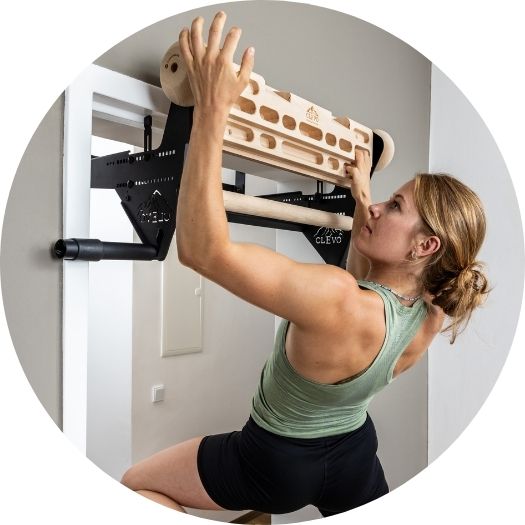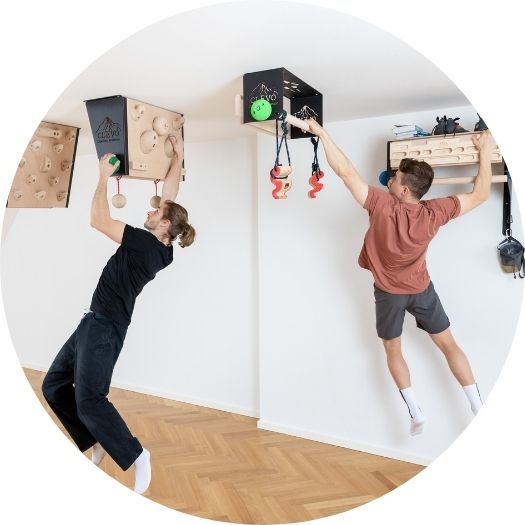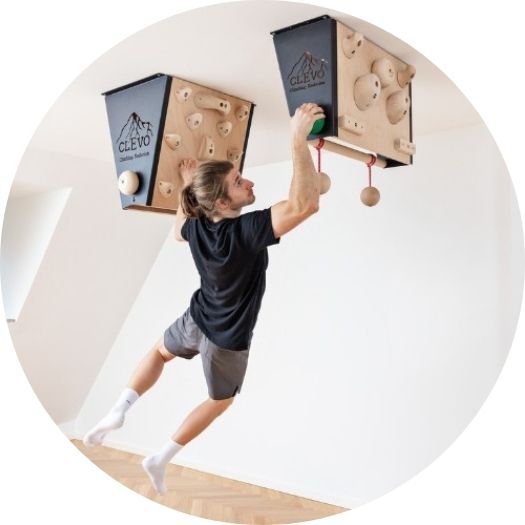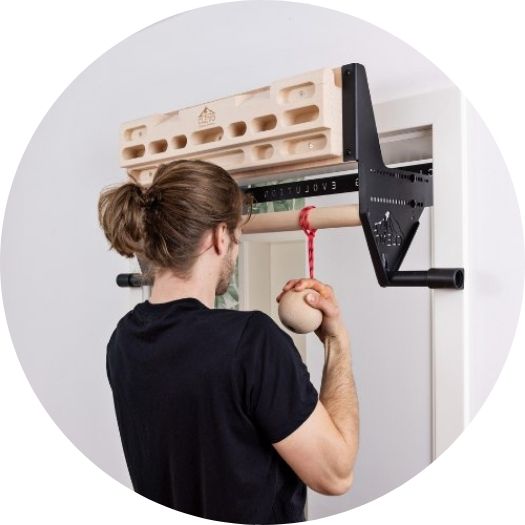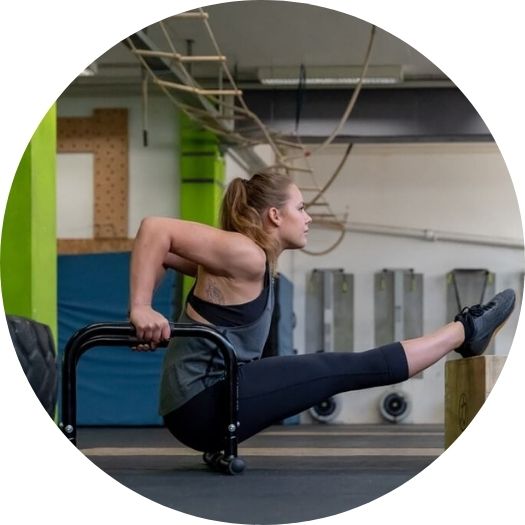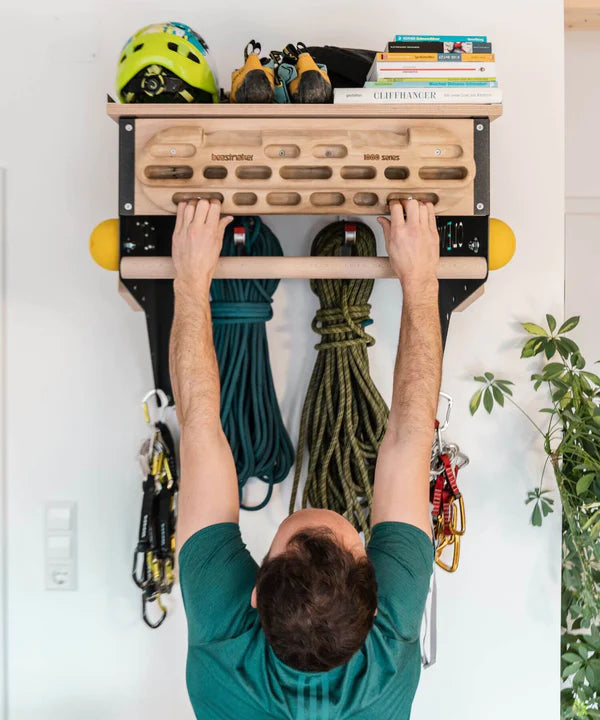What has long been common in nature and in halls is also available for your home: your own climbing wall! With this equipment you can spontaneously hold a training session in your daily routine at any time. The climbing wall for home is smaller than the climbing routes in nature and in halls, but it is completely sufficient to train climbing-specific skills.
In addition to various climbing modules for home, there's various mobile equipment that doesn't live up to the term "climbing wall," but will still give you a brutally efficient workout in preparation for your next climbing and bouldering session outdoors or indoors.
Check out the four options in our blog post to pull off a proper climbing workout in your own home soon!
1st option: Climbing wall for home as a door module.

The climbing module for the door frame offers less support compared to a wall-mounted module, but it is always enough for a decent climbing workout. With the right door module, you will be able to perform a basic and quite intensive climbing training. An excellent door module is our CLEVO DOOR. You simply hang the module in the door frame, whereby the unbeatable advantage is that you can easily remove and reassemble it.
On our door module you have the possibility to attach a fingerboard or single climbing handles. In addition, CLEVO DOOR has an integrated pull-up bar, which will be especially helpful for training your back and biceps muscles - both muscle groups you can't do without when climbing!
Another practical use of our door module: You can keep your hanging gear, part of your climbing accessories, neat and tidy on the module.
Fingerboard climbing training for finger skills!
On your home climbing wall, you can attach a fingerboard. Fingerboards are almost indispensable equipment if you want to bring your finger strength and finger technique to a high level.
I'm sure you can think of a few climbing and bouldering routes where there are such small grip areas that you have to claw and pull yourself up using just the strength of your fingertips - sometimes there's enough room for four fingers, but sometimes you have to make do with two.
The fingerboard on your home climbing wall has more than a dozen different grip surfaces that vary in difficulty. Here you train finger strength and finger technique in an efficient way, creating an excellent foundation for climbing and bouldering - so when it comes down to it on the route, you'll have the finger skills you need!
Pull-up training. Do you really need it? Yes!
Part of our door module as a climbing wall at home is an integrated pull-up bar. But is the bar really useful? The background to this question: there is a dispute among climbers and boulderers about the usefulness of pull-up training. Some cite the specific requirements on climbing and bouldering routes, saying, "Pull-up training is too non-specific and one-sided."
Our take: Who said you have to limit yourself to common pull-ups alone? To complement your climbing workout, pull-ups are an optimal exercise in our eyes, because you have a variety of different pull-up variations open to you to diversify your climbing workout on the pull-up bar:
- Scapula pullups for additional body tension training.
- Single-arm pull-ups for above-average efficiency in biceps training
- Archer pull-ups to challenge the arms individually and simulate climbing-specific demands
These three exercises are just basic examples of how you can use pull-ups on your home climbing wall to make your pull-up training more climbing-specific. Feel free to check out this blog post about different Pull-up variations and get an idea of how versatile pull-ups can be in reality!
Apart from that, pull-ups have the advantage in climbing training that you don 't necessarily have to rely on a climbing module. For example, you can use a door pull-up bar which takes up less space than a door module. If you don't want to install a climbing wall at home right away, a pull-up bar is a good alternative as a space-saving option.
2nd option: Climbing wall for home as wall module

Wall modules like CLEVO WALL extend the possibilities of door modules. You can also attach a fingerboard here. Most of the time you even have space for bigger fingerboards on wall modules than on door modules, which makes your finger training more varied. A pull-up bar is also integrated into the CLEVO WALL wall module.
Apart from fingerboards and pull-up bars, wall modules as a climbing wall at home offer a few additional highlights compared to door modules: For example, with CLEVO WALL, you have half campus ledges attached to the sides of the module. The campus bars are intended for finger training; with CLEVO WALL, the campus bars are small and angled, which is why they contribute to a particularly challenging finger training. In addition to the campus bars, CLEVO WALL has two round climbing holds on the sides, which are a useful addition to your climbing training.
Because the wall module is mounted to your wall with screws at home, you need to find a permanent place for the module. One could consider the fixed mounting as a disadvantage. However, this disadvantage hardly matters, because the module CLEVO WALL even offers a storage place for your books or for decoration. Thus, it is more than just a climbing wall for your home and also satisfies one or two aesthetic demands. Plus, with CLEVO WALL, you have built-in storage where you can easily stash your climbing gear.
At the end of the day, a neat wall module like CLEVO WALL is a kind of 3-in-1 equipment: a shelf space, a storage place and - above all - a very efficient and versatile training module!
3rd option: Climbing wall for home as ceiling module

With a ceiling module you have fierce scope for your climbing training at home! A ceiling module is pretty much the most comprehensive climbing wall for home you can imagine. The CLEVO M BASE MODULE is the best example of how versatile ceiling modules can be. You attach it with the help of screws and you can do the following training on the module, among others:
- Finger strength and technique training on the hangboard and integrated campus bars.
- Pull-up training on the integrated pull-up bar
- Reconstruction of climbing routes with different holds (Note: Due to the large surface area of the base module, smaller climbing routes can be reconstructed with, for example, eight climbing holds - this is the epitome of a climbing wall at home!)
- Attachment of a pegboard to train strength and body tension from the abdomen to the fingers
- Mounting of gymnastic rings to efficiently train the supporting muscles
The CLEVO M BASE MODULE hangs down from the ceiling, giving you plenty of room to mount holds, boards, and other components to create small climbing routes of your own choosing. You can equip both the front and the back of the module with training equipment, e.g. mount a fingerboard and five holds on one side and ten climbing holds on the other.
Simple quintessence: Due to its large surface area, the CLEVO M BASE MODULE is a climbing wall for the home that leaves nothing to be desired in terms of price/performance ratio. It offers you an incredible amount of space to design your own routes. This way you can optimally prepare yourself for the next climbing or bouldering session outside your four walls!
4th option: Mobile equipment as an alternative to the climbing wall at home
Even though this blog post is mainly about the climbing wall at home, we don't want to deprive you of the many options you have for climbing training at home and even outdoors without your own climbing wall. In the following, we will introduce you to three very good alternatives to the climbing wall at home.
Fingerboards attached to the rope

Surely you have noticed that an important part of climbing modules are the so-called fingerboards. They don't necessarily have to be attached to climbing modules. You can just as well use mobile hangboards for training. These are attached via a rope, which is why you can use them both indoors and outdoors.
Mobile fingerboards are especially advantageous for you if you want to have an intensive finger training: Because they are attached to the rope, the fingerboards hang unstably from above, which means that more supporting muscles are involved in the workout during your exercises. You can hardly train your fingers more efficiently!
Gymnastic rings

Speaking of instability and supporting muscles, gymnastic rings have an excellent reputation among climbers and boulderers for training. That's because you can attach gymnastics rings almost anywhere. Whether indoors on hooks or door anchors, on your CLEVO M BASE MODULE on the ceiling, outside on a tree or elsewhere - with gymnastic rings you are very flexible.
For training, the rings are practical because you perform various exercises (pull-ups in different variations, dips, push-ups) on unstable ropes, which means that whole muscle chains are involved in the exercise performance.
By holding specific end positions under high body tension, training on gymnastic rings will excellently prepare you for the "hardmover" routes feared by some climbers and boulderers. Good quality rings for your climbing training are, for example, the Gym Rings from Pullup & Dip.
Combination equipment: bar for pull-ups AND dips

Last but not least, let's not forget that in rare cases it happens that on climbing routes your triceps, shoulder or chest muscles are challenged because you have to push yourself up from a lower hold, for example. If you only train on the home climbing wall, pull-up bars, or fingerboards, you're not getting those muscles ready for specific routes where you have to push yourself up for a change instead of pulling yourself up.
We recommend that you train dips and push-ups in preparation for the very special climbing routes. A practical piece of equipment that you can use to train dips and also pull-ups is the Mobile Pullup & Dip Bar which is a pull-up AND dip bar IN ONE! This bar allows you to train both at home and outdoors.
Conclusion: complement your outdoor and indoor training in an affordable and efficient way!
The climbing wall for home is far from being comparable to the meter-long climbing routes that you master outdoor and in halls. But a climbing wall for home doesn't have to be that big!
In the blog post, we showed you how you can optimally supplement your outdoor and indoor training with individual and comparatively small climbing modules. In the long term, the climbing modules are inexpensive solutions that give you the opportunity to train at home frequently and in a very climbing-specific way.
If you purchase ceiling modules, you have quite a bit of leeway in designing your own climbing routes. The smaller door and wall modules are also sufficient for your training at home, because the point of climbing training at home is not to cover large distances, but to work specifically on the skills where you still have room for improvement.
Build your own climbing wall at home and secure yourself a training opportunity where you save the travel time to the nearest bouldering gym and where, unlike outdoor climbing, you are not dependent on good weather. Happy climbing! 😉

